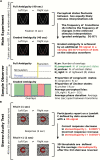Psychotic Experiences in Schizophrenia and Sensitivity to Sensory Evidence
- PMID: 32090246
- PMCID: PMC7345814
- DOI: 10.1093/schbul/sbaa003
Psychotic Experiences in Schizophrenia and Sensitivity to Sensory Evidence
Abstract
Perceptual inference depends on an optimal integration of current sensory evidence with prior beliefs about the environment. Alterations of this process have been related to the emergence of positive symptoms in schizophrenia. However, it has remained unclear whether delusions and hallucinations arise from an increased or decreased weighting of prior beliefs relative to sensory evidence. To investigate the relation of this prior-to-likelihood ratio to positive symptoms in schizophrenia, we devised a novel experimental paradigm which gradually manipulates perceptually ambiguous visual stimuli by disambiguating stimulus information. As a proxy for likelihood precision, we assessed the sensitivity of individual participants to sensory evidence. As a surrogate for the precision of prior beliefs in perceptual stability, we measured phase duration in ambiguity. Relative to healthy controls, patients with schizophrenia showed a stronger increment in congruent perceptual states for increasing levels of disambiguating stimulus evidence. Sensitivity to sensory evidence correlated positively with the individual patients' severity of perceptual anomalies and hallucinations. Moreover, the severity of such experiences correlated negatively with phase duration. Our results indicate that perceptual anomalies and hallucinations are associated with a shift of perceptual inference toward sensory evidence and away from prior beliefs. This reduced prior-to-likelihood ratio in sensory processing may contribute to the phenomenon of aberrant salience, which has been suggested to give rise to the false inferences underlying psychotic experiences.
Keywords: Bayesian perceptual inference; bistable perception; predictive coding; psychosis.
© The Author(s) 2020. Published by Oxford University Press on behalf of the Maryland Psychiatric Research Center. All rights reserved. For permissions, please email: journals.permissions@oup.com.
Figures




Similar articles
-
Shift toward prior knowledge confers a perceptual advantage in early psychosis and psychosis-prone healthy individuals.Proc Natl Acad Sci U S A. 2015 Oct 27;112(43):13401-6. doi: 10.1073/pnas.1503916112. Epub 2015 Oct 12. Proc Natl Acad Sci U S A. 2015. PMID: 26460044 Free PMC article.
-
A Perceptual Inference Mechanism for Hallucinations Linked to Striatal Dopamine.Curr Biol. 2018 Feb 19;28(4):503-514.e4. doi: 10.1016/j.cub.2017.12.059. Epub 2018 Feb 2. Curr Biol. 2018. PMID: 29398218 Free PMC article.
-
The Predictive Coding Account of Psychosis.Biol Psychiatry. 2018 Nov 1;84(9):634-643. doi: 10.1016/j.biopsych.2018.05.015. Epub 2018 May 25. Biol Psychiatry. 2018. PMID: 30007575 Free PMC article. Review.
-
Immersion in altered experience: An investigation of the relationship between absorption and psychopathology.Conscious Cogn. 2017 Mar;49:215-226. doi: 10.1016/j.concog.2017.01.015. Epub 2017 Feb 20. Conscious Cogn. 2017. PMID: 28219788 Free PMC article.
-
Towards a Unifying Cognitive, Neurophysiological, and Computational Neuroscience Account of Schizophrenia.Schizophr Bull. 2019 Sep 11;45(5):1092-1100. doi: 10.1093/schbul/sby154. Schizophr Bull. 2019. PMID: 30388260 Free PMC article. Review.
Cited by
-
Bayesian accounts of perceptual decisions in the nonclinical continuum of psychosis: Greater imprecision in both top-down and bottom-up processes.PLoS Comput Biol. 2023 Nov 21;19(11):e1011670. doi: 10.1371/journal.pcbi.1011670. eCollection 2023 Nov. PLoS Comput Biol. 2023. PMID: 37988398 Free PMC article.
-
N-methyl-d-aspartate receptor hypofunction causes recurrent and transient failures of perceptual inference.Brain. 2025 May 13;148(5):1531-1539. doi: 10.1093/brain/awaf011. Brain. 2025. PMID: 39821016 Free PMC article. Clinical Trial.
-
Cross-Modality Evidence for Reduced Choice History Biases in Psychosis-Prone Individuals.Schizophr Bull. 2023 Mar 15;49(2):397-406. doi: 10.1093/schbul/sbac168. Schizophr Bull. 2023. PMID: 36440751 Free PMC article.
-
Bistable perception alternates between internal and external modes of sensory processing.iScience. 2021 Feb 26;24(3):102234. doi: 10.1016/j.isci.2021.102234. eCollection 2021 Mar 19. iScience. 2021. PMID: 33748716 Free PMC article.
-
Resolving the Delusion Paradox.Schizophr Bull. 2023 Nov 29;49(6):1425-1436. doi: 10.1093/schbul/sbad084. Schizophr Bull. 2023. PMID: 37478890 Free PMC article. Review.
References
-
- Lee TS, Mumford D. Hierarchical Bayesian inference in the visual cortex. J Opt Soc Am A Opt Image Sci Vis. 2003;20(7):1434–1448. - PubMed
-
- Clark A. Whatever next? Predictive brains, situated agents, and the future of cognitive science. Behav Brain Sci. 2013;36(3):181–204. - PubMed
-
- Clark A. Surfing Uncertainty: Prediction, Action and The Embodied Mind. Oxford, UK: Oxford University Press; 2016:424.
Publication types
MeSH terms
LinkOut - more resources
Full Text Sources
Medical
Research Materials

